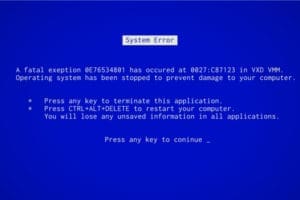 We’ve all been there: A big presentation in front of the boss is felled by tech trouble. The Wi-Fi goes down, the HDMI cable suddenly fails, an unfortunate video autoplays, etc. Next time this happens, all you need to do is pick yourself up and dust yourself off. Why? Because even the bigwigs at Microsoft experience such misfortune.
We’ve all been there: A big presentation in front of the boss is felled by tech trouble. The Wi-Fi goes down, the HDMI cable suddenly fails, an unfortunate video autoplays, etc. Next time this happens, all you need to do is pick yourself up and dust yourself off. Why? Because even the bigwigs at Microsoft experience such misfortune.
On April 20, 1998, Gates and Chris Capossela (now Microsoft’s chief marketing officer) were on stage at Comdex in Chicago, preparing to demonstrate the plug-and-play technology of Windows 98. Capossella plugged in a scanner, explained how the operating system would load the appropriate drivers, and then … whoa. The infamous ‘blue screen of death’ (Capossela’s “whoa” sound is worth a watch on YouTube).
To Gates’ credit, he didn’t miss a beat. He laughed along with the audience and said, “That must be why we’re not shipping Windows 98 yet.”
The blue screen’s silver lining
The dreaded ‘blue screen of death’ has been a Windows feature since Windows 3.0. While it means you’re going to lose any unsaved work, it also prevents further damage to your machine. It’s an indication the system is shutting down because it can no longer operate safely. Your only choice is a restart.
The initial blue screen of death was reportedly a bug noticed by developers at Lattice Inc. as they worked on an early version of Windows. Calling the error screen the “blue screen of death” was a bit of a dig at IBM’s blue branding. Microsoft decided to put the blue screen to work and use it to display helpful error codes. In 2012, the technical information was humanized with the addition of a frowning emoticon.
Photo: Oleksii Arseniuk / Shutterstock
